Regulatory Process: Pesticide Regulation and Environmental Impact
VerifiedAdded on 2023/05/30
|6
|2002
|397
Report
AI Summary
This report delves into the regulatory processes surrounding pesticides, comparing organic and non-organic options and their respective impacts on the environment and human health. It discusses the advantages of organic farming over conventional methods, highlighting the reduced environmental impact and health risks associated with organic practices. The report also examines the use and regulation of DDT, an insecticide with long-lasting environmental persistence and potential health hazards, including carcinogenicity. Furthermore, it explores the varying allowable concentrations of pesticides in food substances across different countries and addresses the importance of using animal studies to determine safe levels. Finally, the report compares chemical regulations in the European Union (REACH) with those in Canada, noting similarities in protecting citizens from harmful chemicals, requiring risk communication, and mandating specific notification requirements for chemical substances.
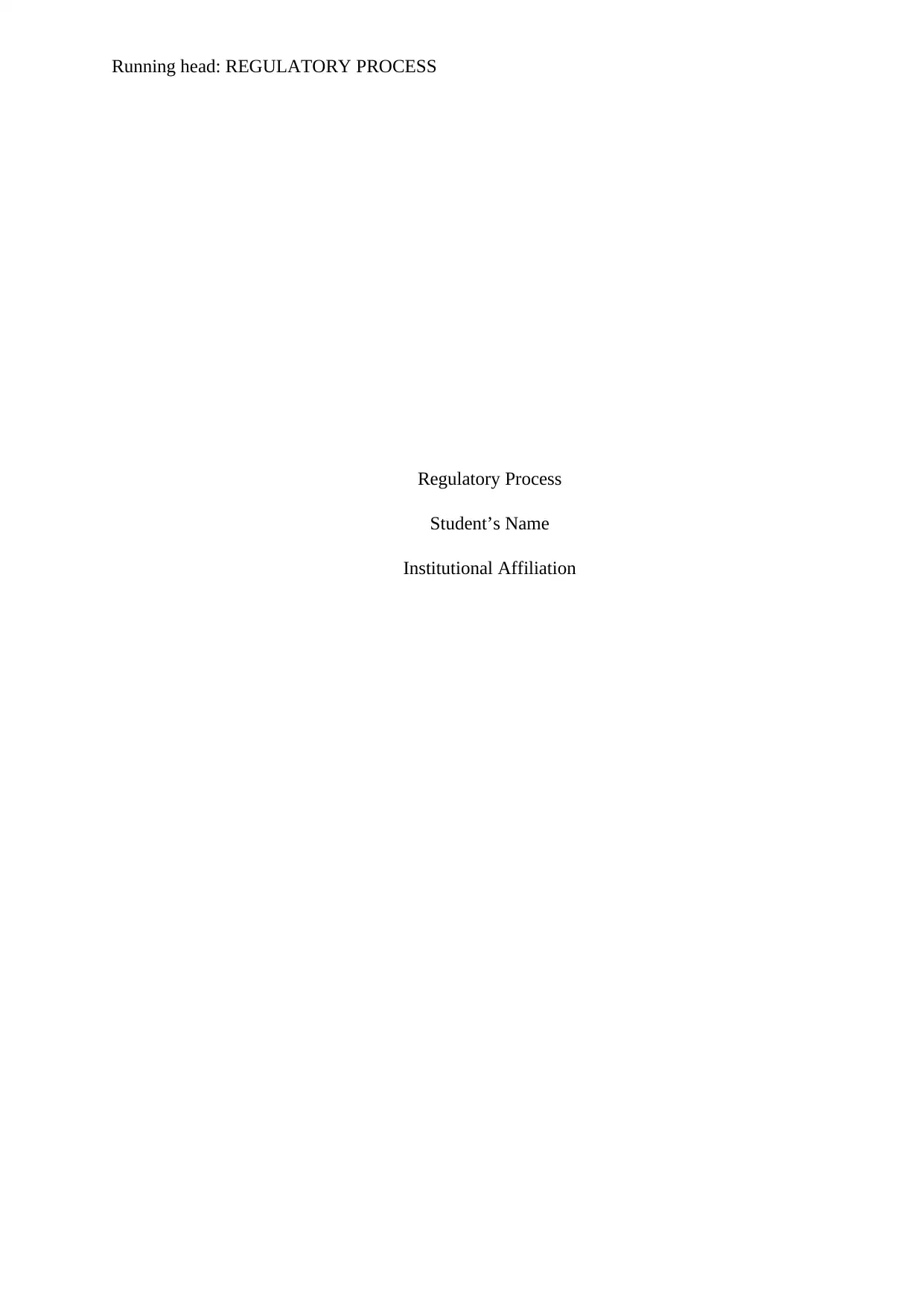
Running head: REGULATORY PROCESS
Regulatory Process
Student’s Name
Institutional Affiliation
Regulatory Process
Student’s Name
Institutional Affiliation
Paraphrase This Document
Need a fresh take? Get an instant paraphrase of this document with our AI Paraphraser
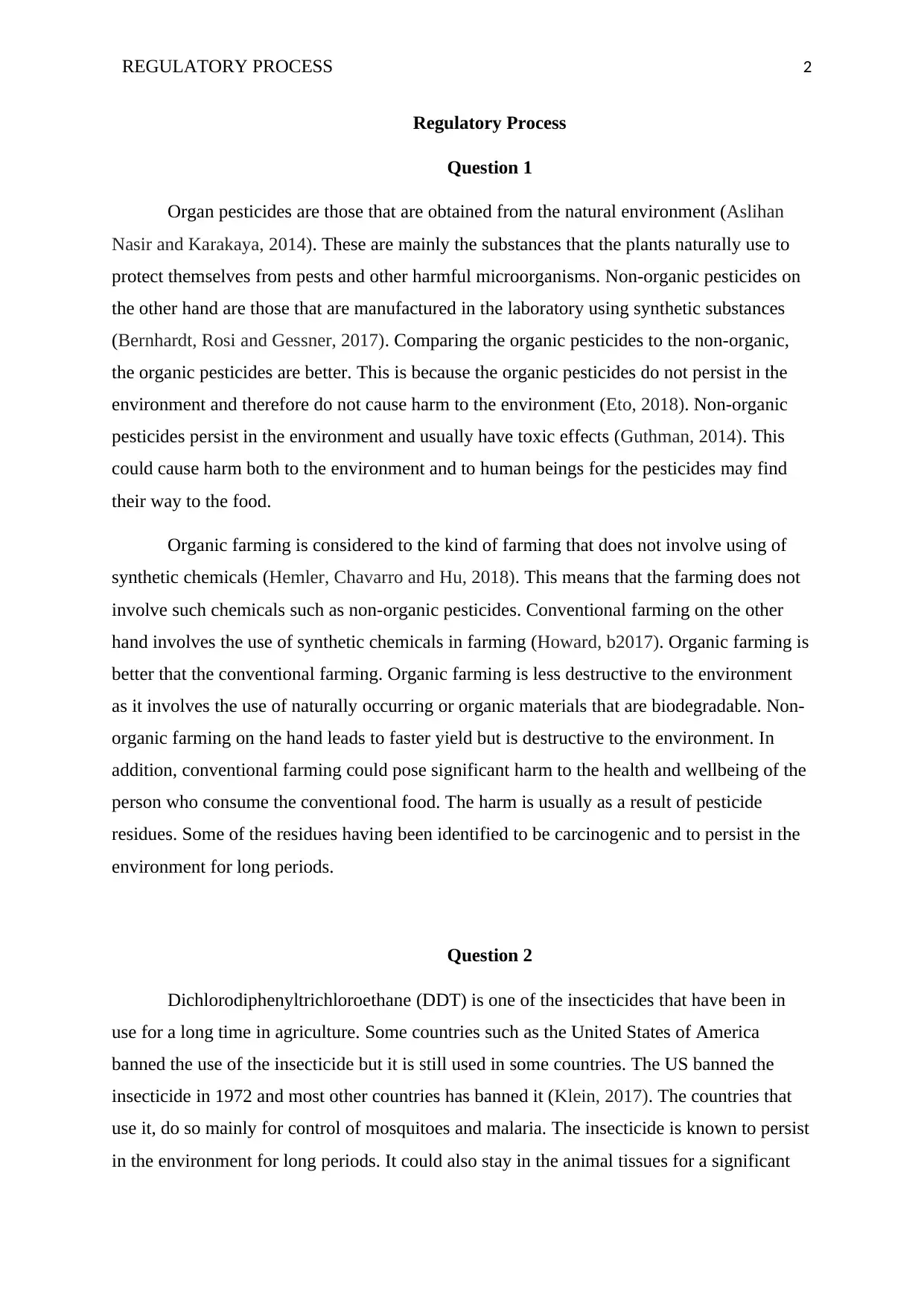
REGULATORY PROCESS 2
Regulatory Process
Question 1
Organ pesticides are those that are obtained from the natural environment (Aslihan
Nasir and Karakaya, 2014). These are mainly the substances that the plants naturally use to
protect themselves from pests and other harmful microorganisms. Non-organic pesticides on
the other hand are those that are manufactured in the laboratory using synthetic substances
(Bernhardt, Rosi and Gessner, 2017). Comparing the organic pesticides to the non-organic,
the organic pesticides are better. This is because the organic pesticides do not persist in the
environment and therefore do not cause harm to the environment (Eto, 2018). Non-organic
pesticides persist in the environment and usually have toxic effects (Guthman, 2014). This
could cause harm both to the environment and to human beings for the pesticides may find
their way to the food.
Organic farming is considered to the kind of farming that does not involve using of
synthetic chemicals (Hemler, Chavarro and Hu, 2018). This means that the farming does not
involve such chemicals such as non-organic pesticides. Conventional farming on the other
hand involves the use of synthetic chemicals in farming (Howard, b2017). Organic farming is
better that the conventional farming. Organic farming is less destructive to the environment
as it involves the use of naturally occurring or organic materials that are biodegradable. Non-
organic farming on the hand leads to faster yield but is destructive to the environment. In
addition, conventional farming could pose significant harm to the health and wellbeing of the
person who consume the conventional food. The harm is usually as a result of pesticide
residues. Some of the residues having been identified to be carcinogenic and to persist in the
environment for long periods.
Question 2
Dichlorodiphenyltrichloroethane (DDT) is one of the insecticides that have been in
use for a long time in agriculture. Some countries such as the United States of America
banned the use of the insecticide but it is still used in some countries. The US banned the
insecticide in 1972 and most other countries has banned it (Klein, 2017). The countries that
use it, do so mainly for control of mosquitoes and malaria. The insecticide is known to persist
in the environment for long periods. It could also stay in the animal tissues for a significant
Regulatory Process
Question 1
Organ pesticides are those that are obtained from the natural environment (Aslihan
Nasir and Karakaya, 2014). These are mainly the substances that the plants naturally use to
protect themselves from pests and other harmful microorganisms. Non-organic pesticides on
the other hand are those that are manufactured in the laboratory using synthetic substances
(Bernhardt, Rosi and Gessner, 2017). Comparing the organic pesticides to the non-organic,
the organic pesticides are better. This is because the organic pesticides do not persist in the
environment and therefore do not cause harm to the environment (Eto, 2018). Non-organic
pesticides persist in the environment and usually have toxic effects (Guthman, 2014). This
could cause harm both to the environment and to human beings for the pesticides may find
their way to the food.
Organic farming is considered to the kind of farming that does not involve using of
synthetic chemicals (Hemler, Chavarro and Hu, 2018). This means that the farming does not
involve such chemicals such as non-organic pesticides. Conventional farming on the other
hand involves the use of synthetic chemicals in farming (Howard, b2017). Organic farming is
better that the conventional farming. Organic farming is less destructive to the environment
as it involves the use of naturally occurring or organic materials that are biodegradable. Non-
organic farming on the hand leads to faster yield but is destructive to the environment. In
addition, conventional farming could pose significant harm to the health and wellbeing of the
person who consume the conventional food. The harm is usually as a result of pesticide
residues. Some of the residues having been identified to be carcinogenic and to persist in the
environment for long periods.
Question 2
Dichlorodiphenyltrichloroethane (DDT) is one of the insecticides that have been in
use for a long time in agriculture. Some countries such as the United States of America
banned the use of the insecticide but it is still used in some countries. The US banned the
insecticide in 1972 and most other countries has banned it (Klein, 2017). The countries that
use it, do so mainly for control of mosquitoes and malaria. The insecticide is known to persist
in the environment for long periods. It could also stay in the animal tissues for a significant
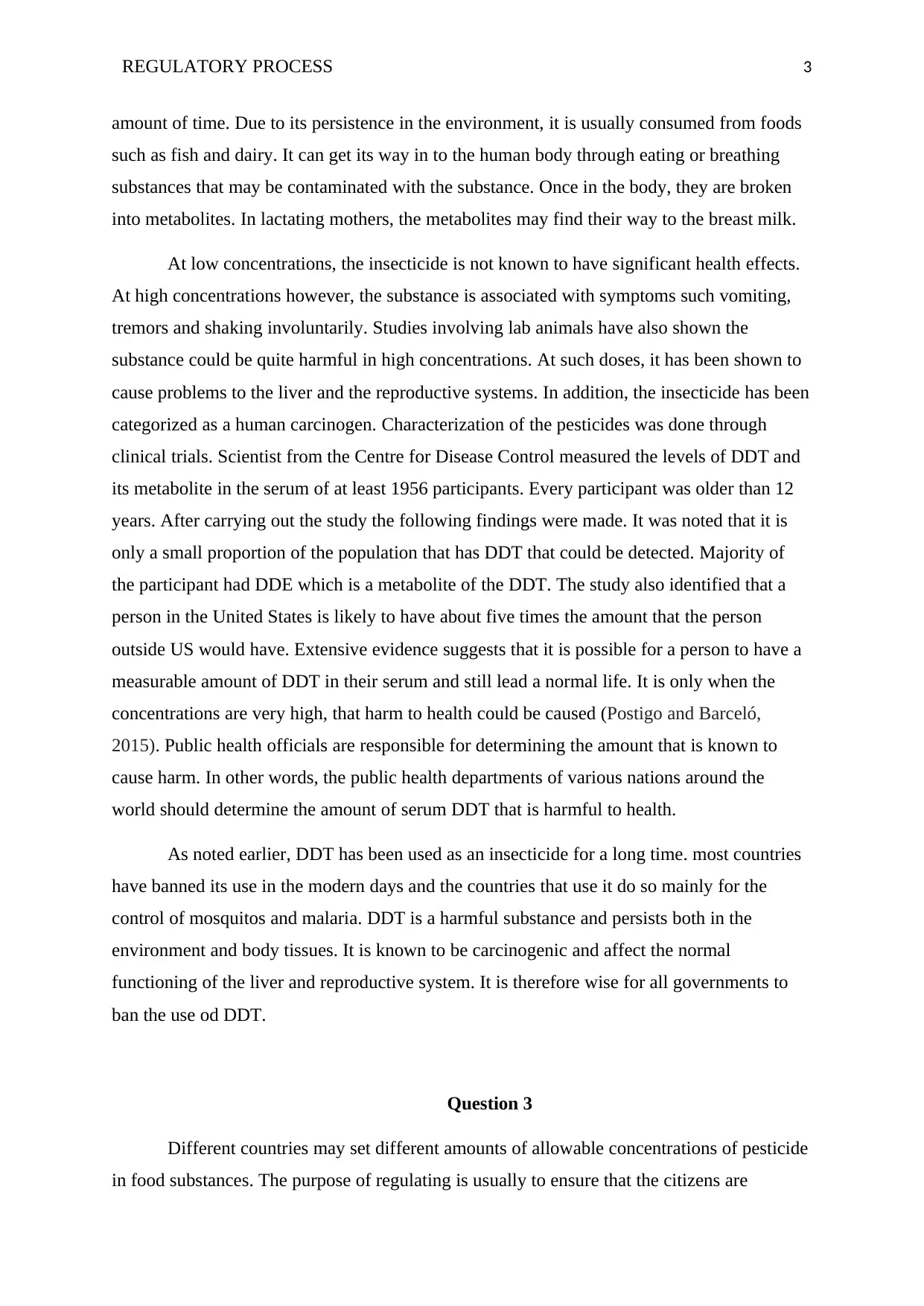
REGULATORY PROCESS 3
amount of time. Due to its persistence in the environment, it is usually consumed from foods
such as fish and dairy. It can get its way in to the human body through eating or breathing
substances that may be contaminated with the substance. Once in the body, they are broken
into metabolites. In lactating mothers, the metabolites may find their way to the breast milk.
At low concentrations, the insecticide is not known to have significant health effects.
At high concentrations however, the substance is associated with symptoms such vomiting,
tremors and shaking involuntarily. Studies involving lab animals have also shown the
substance could be quite harmful in high concentrations. At such doses, it has been shown to
cause problems to the liver and the reproductive systems. In addition, the insecticide has been
categorized as a human carcinogen. Characterization of the pesticides was done through
clinical trials. Scientist from the Centre for Disease Control measured the levels of DDT and
its metabolite in the serum of at least 1956 participants. Every participant was older than 12
years. After carrying out the study the following findings were made. It was noted that it is
only a small proportion of the population that has DDT that could be detected. Majority of
the participant had DDE which is a metabolite of the DDT. The study also identified that a
person in the United States is likely to have about five times the amount that the person
outside US would have. Extensive evidence suggests that it is possible for a person to have a
measurable amount of DDT in their serum and still lead a normal life. It is only when the
concentrations are very high, that harm to health could be caused (Postigo and Barceló,
2015). Public health officials are responsible for determining the amount that is known to
cause harm. In other words, the public health departments of various nations around the
world should determine the amount of serum DDT that is harmful to health.
As noted earlier, DDT has been used as an insecticide for a long time. most countries
have banned its use in the modern days and the countries that use it do so mainly for the
control of mosquitos and malaria. DDT is a harmful substance and persists both in the
environment and body tissues. It is known to be carcinogenic and affect the normal
functioning of the liver and reproductive system. It is therefore wise for all governments to
ban the use od DDT.
Question 3
Different countries may set different amounts of allowable concentrations of pesticide
in food substances. The purpose of regulating is usually to ensure that the citizens are
amount of time. Due to its persistence in the environment, it is usually consumed from foods
such as fish and dairy. It can get its way in to the human body through eating or breathing
substances that may be contaminated with the substance. Once in the body, they are broken
into metabolites. In lactating mothers, the metabolites may find their way to the breast milk.
At low concentrations, the insecticide is not known to have significant health effects.
At high concentrations however, the substance is associated with symptoms such vomiting,
tremors and shaking involuntarily. Studies involving lab animals have also shown the
substance could be quite harmful in high concentrations. At such doses, it has been shown to
cause problems to the liver and the reproductive systems. In addition, the insecticide has been
categorized as a human carcinogen. Characterization of the pesticides was done through
clinical trials. Scientist from the Centre for Disease Control measured the levels of DDT and
its metabolite in the serum of at least 1956 participants. Every participant was older than 12
years. After carrying out the study the following findings were made. It was noted that it is
only a small proportion of the population that has DDT that could be detected. Majority of
the participant had DDE which is a metabolite of the DDT. The study also identified that a
person in the United States is likely to have about five times the amount that the person
outside US would have. Extensive evidence suggests that it is possible for a person to have a
measurable amount of DDT in their serum and still lead a normal life. It is only when the
concentrations are very high, that harm to health could be caused (Postigo and Barceló,
2015). Public health officials are responsible for determining the amount that is known to
cause harm. In other words, the public health departments of various nations around the
world should determine the amount of serum DDT that is harmful to health.
As noted earlier, DDT has been used as an insecticide for a long time. most countries
have banned its use in the modern days and the countries that use it do so mainly for the
control of mosquitos and malaria. DDT is a harmful substance and persists both in the
environment and body tissues. It is known to be carcinogenic and affect the normal
functioning of the liver and reproductive system. It is therefore wise for all governments to
ban the use od DDT.
Question 3
Different countries may set different amounts of allowable concentrations of pesticide
in food substances. The purpose of regulating is usually to ensure that the citizens are
⊘ This is a preview!⊘
Do you want full access?
Subscribe today to unlock all pages.

Trusted by 1+ million students worldwide
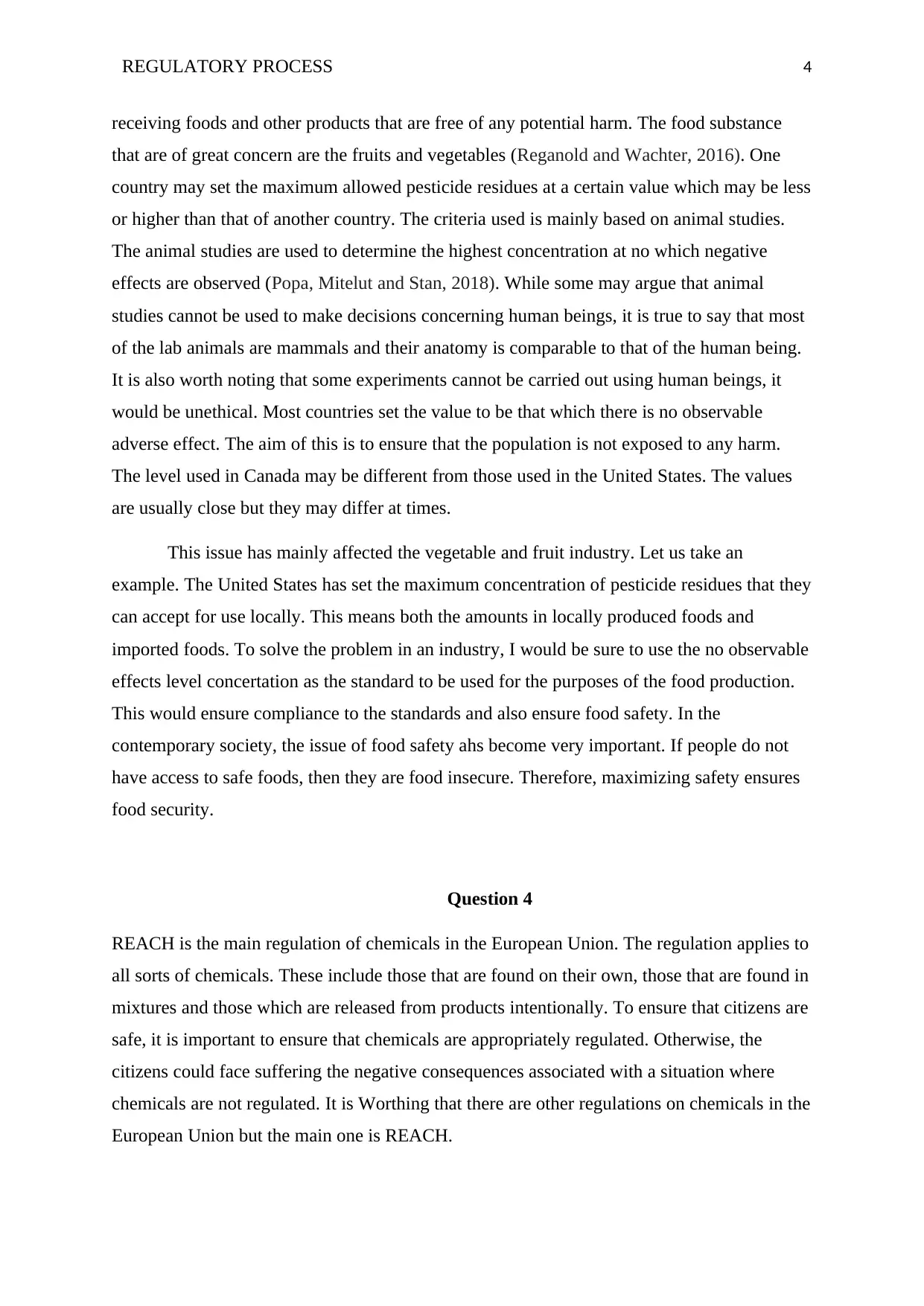
REGULATORY PROCESS 4
receiving foods and other products that are free of any potential harm. The food substance
that are of great concern are the fruits and vegetables (Reganold and Wachter, 2016). One
country may set the maximum allowed pesticide residues at a certain value which may be less
or higher than that of another country. The criteria used is mainly based on animal studies.
The animal studies are used to determine the highest concentration at no which negative
effects are observed (Popa, Mitelut and Stan, 2018). While some may argue that animal
studies cannot be used to make decisions concerning human beings, it is true to say that most
of the lab animals are mammals and their anatomy is comparable to that of the human being.
It is also worth noting that some experiments cannot be carried out using human beings, it
would be unethical. Most countries set the value to be that which there is no observable
adverse effect. The aim of this is to ensure that the population is not exposed to any harm.
The level used in Canada may be different from those used in the United States. The values
are usually close but they may differ at times.
This issue has mainly affected the vegetable and fruit industry. Let us take an
example. The United States has set the maximum concentration of pesticide residues that they
can accept for use locally. This means both the amounts in locally produced foods and
imported foods. To solve the problem in an industry, I would be sure to use the no observable
effects level concertation as the standard to be used for the purposes of the food production.
This would ensure compliance to the standards and also ensure food safety. In the
contemporary society, the issue of food safety ahs become very important. If people do not
have access to safe foods, then they are food insecure. Therefore, maximizing safety ensures
food security.
Question 4
REACH is the main regulation of chemicals in the European Union. The regulation applies to
all sorts of chemicals. These include those that are found on their own, those that are found in
mixtures and those which are released from products intentionally. To ensure that citizens are
safe, it is important to ensure that chemicals are appropriately regulated. Otherwise, the
citizens could face suffering the negative consequences associated with a situation where
chemicals are not regulated. It is Worthing that there are other regulations on chemicals in the
European Union but the main one is REACH.
receiving foods and other products that are free of any potential harm. The food substance
that are of great concern are the fruits and vegetables (Reganold and Wachter, 2016). One
country may set the maximum allowed pesticide residues at a certain value which may be less
or higher than that of another country. The criteria used is mainly based on animal studies.
The animal studies are used to determine the highest concentration at no which negative
effects are observed (Popa, Mitelut and Stan, 2018). While some may argue that animal
studies cannot be used to make decisions concerning human beings, it is true to say that most
of the lab animals are mammals and their anatomy is comparable to that of the human being.
It is also worth noting that some experiments cannot be carried out using human beings, it
would be unethical. Most countries set the value to be that which there is no observable
adverse effect. The aim of this is to ensure that the population is not exposed to any harm.
The level used in Canada may be different from those used in the United States. The values
are usually close but they may differ at times.
This issue has mainly affected the vegetable and fruit industry. Let us take an
example. The United States has set the maximum concentration of pesticide residues that they
can accept for use locally. This means both the amounts in locally produced foods and
imported foods. To solve the problem in an industry, I would be sure to use the no observable
effects level concertation as the standard to be used for the purposes of the food production.
This would ensure compliance to the standards and also ensure food safety. In the
contemporary society, the issue of food safety ahs become very important. If people do not
have access to safe foods, then they are food insecure. Therefore, maximizing safety ensures
food security.
Question 4
REACH is the main regulation of chemicals in the European Union. The regulation applies to
all sorts of chemicals. These include those that are found on their own, those that are found in
mixtures and those which are released from products intentionally. To ensure that citizens are
safe, it is important to ensure that chemicals are appropriately regulated. Otherwise, the
citizens could face suffering the negative consequences associated with a situation where
chemicals are not regulated. It is Worthing that there are other regulations on chemicals in the
European Union but the main one is REACH.
Paraphrase This Document
Need a fresh take? Get an instant paraphrase of this document with our AI Paraphraser
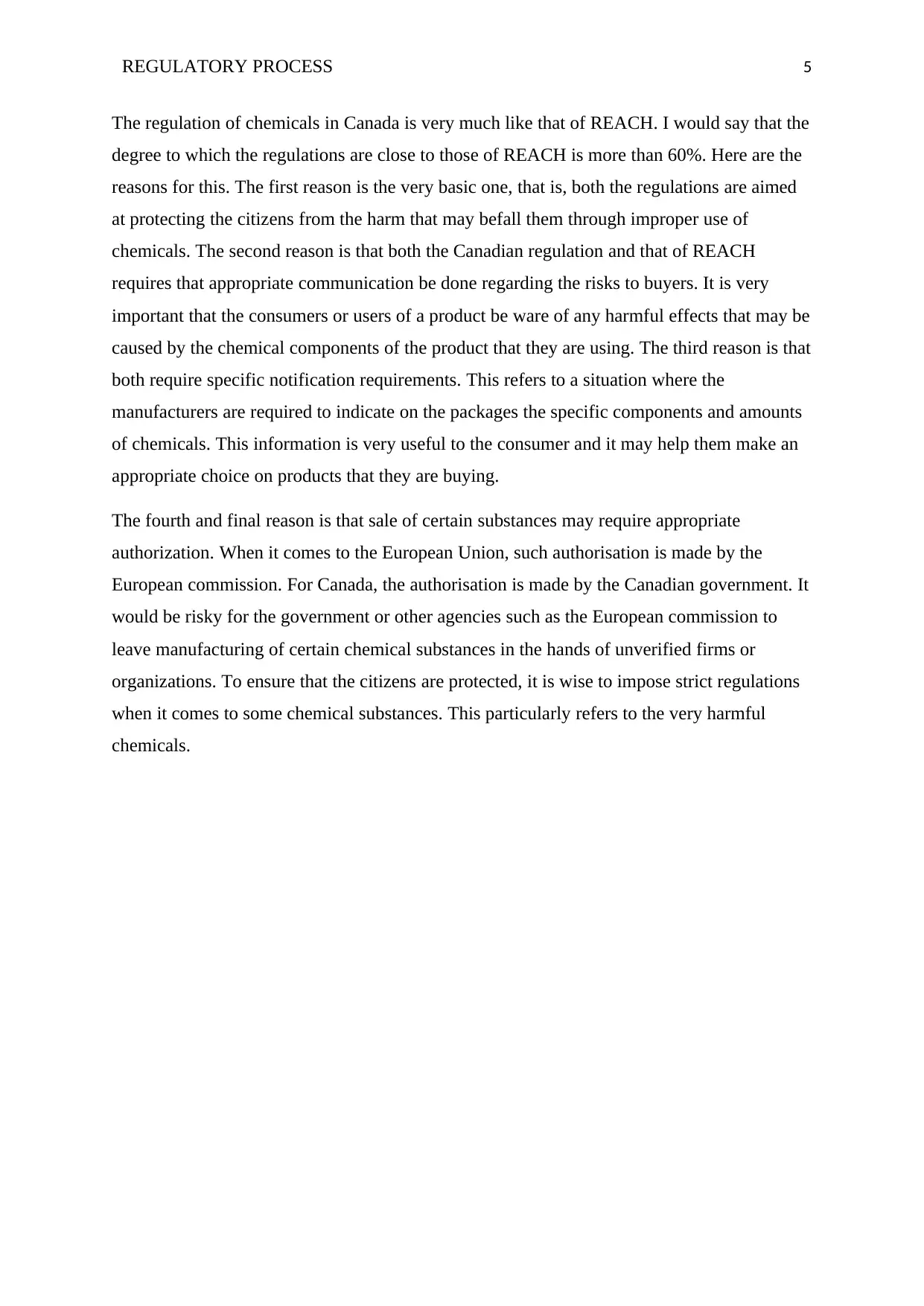
REGULATORY PROCESS 5
The regulation of chemicals in Canada is very much like that of REACH. I would say that the
degree to which the regulations are close to those of REACH is more than 60%. Here are the
reasons for this. The first reason is the very basic one, that is, both the regulations are aimed
at protecting the citizens from the harm that may befall them through improper use of
chemicals. The second reason is that both the Canadian regulation and that of REACH
requires that appropriate communication be done regarding the risks to buyers. It is very
important that the consumers or users of a product be ware of any harmful effects that may be
caused by the chemical components of the product that they are using. The third reason is that
both require specific notification requirements. This refers to a situation where the
manufacturers are required to indicate on the packages the specific components and amounts
of chemicals. This information is very useful to the consumer and it may help them make an
appropriate choice on products that they are buying.
The fourth and final reason is that sale of certain substances may require appropriate
authorization. When it comes to the European Union, such authorisation is made by the
European commission. For Canada, the authorisation is made by the Canadian government. It
would be risky for the government or other agencies such as the European commission to
leave manufacturing of certain chemical substances in the hands of unverified firms or
organizations. To ensure that the citizens are protected, it is wise to impose strict regulations
when it comes to some chemical substances. This particularly refers to the very harmful
chemicals.
The regulation of chemicals in Canada is very much like that of REACH. I would say that the
degree to which the regulations are close to those of REACH is more than 60%. Here are the
reasons for this. The first reason is the very basic one, that is, both the regulations are aimed
at protecting the citizens from the harm that may befall them through improper use of
chemicals. The second reason is that both the Canadian regulation and that of REACH
requires that appropriate communication be done regarding the risks to buyers. It is very
important that the consumers or users of a product be ware of any harmful effects that may be
caused by the chemical components of the product that they are using. The third reason is that
both require specific notification requirements. This refers to a situation where the
manufacturers are required to indicate on the packages the specific components and amounts
of chemicals. This information is very useful to the consumer and it may help them make an
appropriate choice on products that they are buying.
The fourth and final reason is that sale of certain substances may require appropriate
authorization. When it comes to the European Union, such authorisation is made by the
European commission. For Canada, the authorisation is made by the Canadian government. It
would be risky for the government or other agencies such as the European commission to
leave manufacturing of certain chemical substances in the hands of unverified firms or
organizations. To ensure that the citizens are protected, it is wise to impose strict regulations
when it comes to some chemical substances. This particularly refers to the very harmful
chemicals.
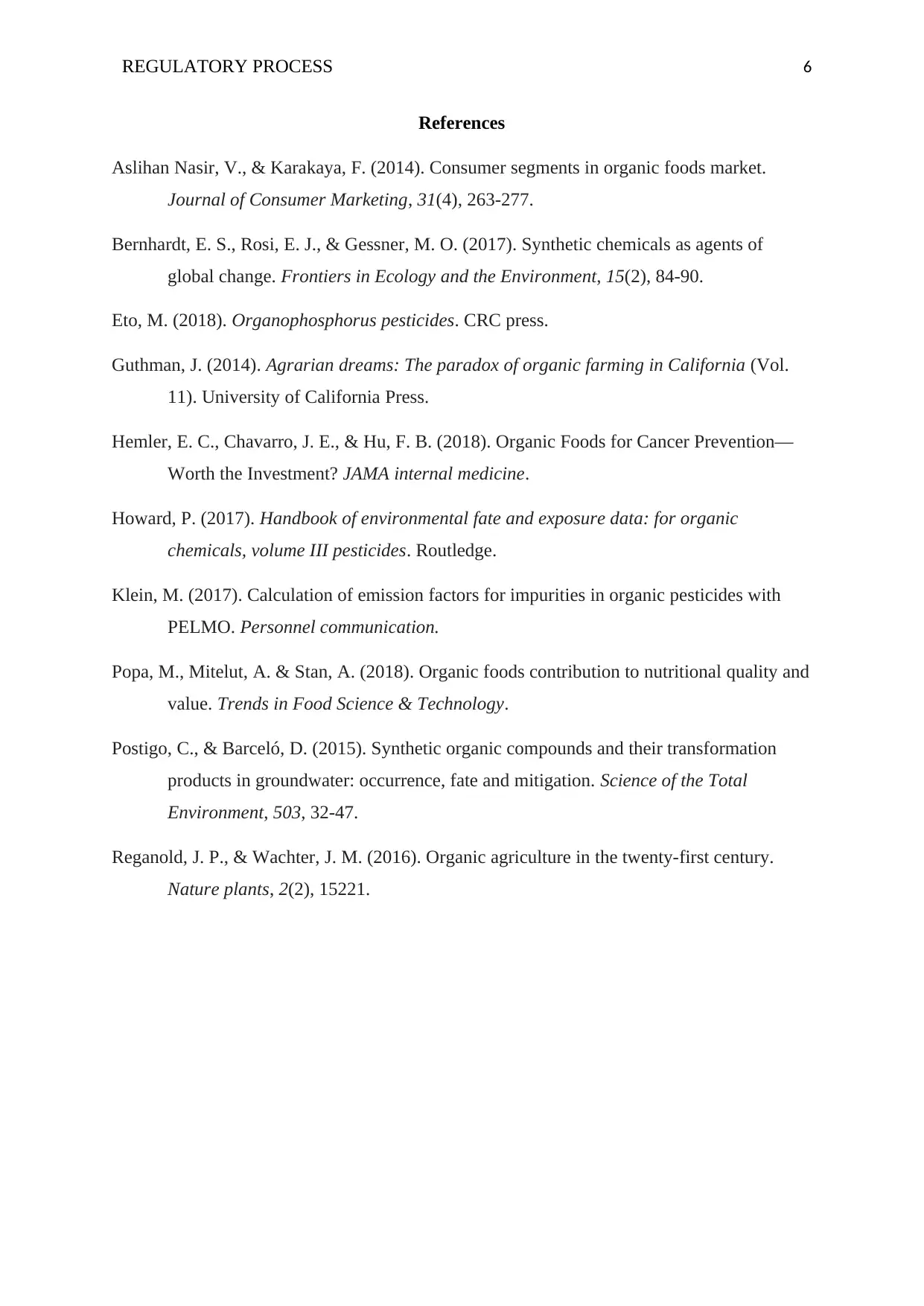
REGULATORY PROCESS 6
References
Aslihan Nasir, V., & Karakaya, F. (2014). Consumer segments in organic foods market.
Journal of Consumer Marketing, 31(4), 263-277.
Bernhardt, E. S., Rosi, E. J., & Gessner, M. O. (2017). Synthetic chemicals as agents of
global change. Frontiers in Ecology and the Environment, 15(2), 84-90.
Eto, M. (2018). Organophosphorus pesticides. CRC press.
Guthman, J. (2014). Agrarian dreams: The paradox of organic farming in California (Vol.
11). University of California Press.
Hemler, E. C., Chavarro, J. E., & Hu, F. B. (2018). Organic Foods for Cancer Prevention—
Worth the Investment? JAMA internal medicine.
Howard, P. (2017). Handbook of environmental fate and exposure data: for organic
chemicals, volume III pesticides. Routledge.
Klein, M. (2017). Calculation of emission factors for impurities in organic pesticides with
PELMO. Personnel communication.
Popa, M., Mitelut, A. & Stan, A. (2018). Organic foods contribution to nutritional quality and
value. Trends in Food Science & Technology.
Postigo, C., & Barceló, D. (2015). Synthetic organic compounds and their transformation
products in groundwater: occurrence, fate and mitigation. Science of the Total
Environment, 503, 32-47.
Reganold, J. P., & Wachter, J. M. (2016). Organic agriculture in the twenty-first century.
Nature plants, 2(2), 15221.
References
Aslihan Nasir, V., & Karakaya, F. (2014). Consumer segments in organic foods market.
Journal of Consumer Marketing, 31(4), 263-277.
Bernhardt, E. S., Rosi, E. J., & Gessner, M. O. (2017). Synthetic chemicals as agents of
global change. Frontiers in Ecology and the Environment, 15(2), 84-90.
Eto, M. (2018). Organophosphorus pesticides. CRC press.
Guthman, J. (2014). Agrarian dreams: The paradox of organic farming in California (Vol.
11). University of California Press.
Hemler, E. C., Chavarro, J. E., & Hu, F. B. (2018). Organic Foods for Cancer Prevention—
Worth the Investment? JAMA internal medicine.
Howard, P. (2017). Handbook of environmental fate and exposure data: for organic
chemicals, volume III pesticides. Routledge.
Klein, M. (2017). Calculation of emission factors for impurities in organic pesticides with
PELMO. Personnel communication.
Popa, M., Mitelut, A. & Stan, A. (2018). Organic foods contribution to nutritional quality and
value. Trends in Food Science & Technology.
Postigo, C., & Barceló, D. (2015). Synthetic organic compounds and their transformation
products in groundwater: occurrence, fate and mitigation. Science of the Total
Environment, 503, 32-47.
Reganold, J. P., & Wachter, J. M. (2016). Organic agriculture in the twenty-first century.
Nature plants, 2(2), 15221.
⊘ This is a preview!⊘
Do you want full access?
Subscribe today to unlock all pages.

Trusted by 1+ million students worldwide
1 out of 6
Related Documents
Your All-in-One AI-Powered Toolkit for Academic Success.
+13062052269
info@desklib.com
Available 24*7 on WhatsApp / Email
![[object Object]](/_next/static/media/star-bottom.7253800d.svg)
Unlock your academic potential
Copyright © 2020–2025 A2Z Services. All Rights Reserved. Developed and managed by ZUCOL.



